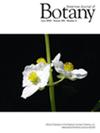Leaf functional traits and ecological niche of Fagus grandifolia and Oreomunnea mexicana in natural forests and plantings as a proxy of climate change
Abstract
Premise
Functional traits reflect species’ responses to environmental variation and the breadth of their ecological niches. Fagus grandifolia and Oreomunnea mexicana have restricted distribution in upper montane cloud forests (1700–2000 m a.s.l.) in Mexico. These species were introduced into plantings at lower elevations (1200–1600 m a.s.l.) that have climates predicted for montane forests in 2050 and 2070. The aim was to relate morphological leaf traits to the ecological niche structure of each species.
Methods
Leaf functional traits (leaf area, specific leaf area [SLA], thickness, and toughness) were analyzed in forests and plantings. Atmospheric circulation models and representative concentration pathways (RCPs: 2.6, 4.5, 8.5) were used to assess future climate conditions. Trait–niche relationships were analyzed by measuring the Mahalanobis distance (MD) from the forests and the plantings to the ecological niche centroid (ENC).
Results
For both species, leaf area and SLA were higher and toughness lower in plantings at lower elevation relative to those in higher-elevation forests, and thickness was similar. Leaf traits varied with distance from sites to the ENC. Forests and plantings have different environmental locations regarding the ENC, but forests are closer (MD 0.34–0.58) than plantings (MD 0.50–0.70) for both species.
Conclusions
Elevation as a proxy for expected future climate conditions influenced the functional traits of both species, and trait patterns related to the structure of their ecological niches were consistent. The use of distances to the ENC is a promising approach to explore variability in species’ functional traits and phenotypic responses in optimal versus marginal environmental conditions.


 求助内容:
求助内容: 应助结果提醒方式:
应助结果提醒方式:


